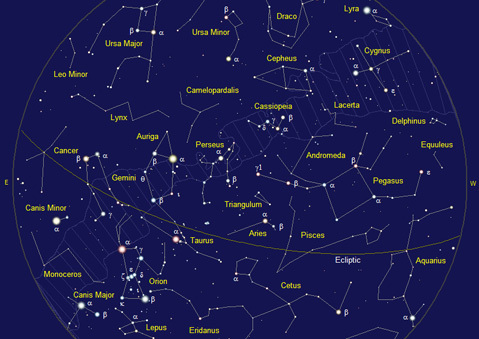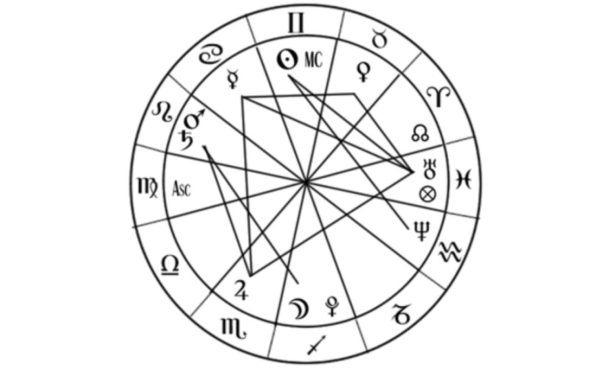Stargazing the Summer Sky

Ready to join Santa Barbara’s stargazing masses? Here’s what to look for in the summertime skies.
Ursa Major: The most widely known constellation in the northern hemisphere, where it’s visible year-round, is Ursa Major, also known as the “Great Bear,” the “Big Dipper,” or the “Plough.” During the summer, it’s in the northwestern part of our night sky. Even though it doesn’t contain remarkably bright stars, it is readily recognizable because of its distinctive pattern and the seven moderately bright stars that outline it. The star Alkaid makes up the tip of the “handle” of the dipper, or the tip of the bear’s tail, while Dubhe and Merak make up the far edge of the “cup,” or the front of the bear. Making an imaginary line from Merak to Dubhe and then continuing in that direction beyond the constellation will lead an observer to Polaris, the North Star. In the middle of the “handle” is a famous optical double star, formed by Mizar and Alcor, which keen eyesight or binoculars can separate.
Ursa Minor: Latin for the “Lesser Bear” and also known as the “Little Dipper,” Ursa Minor is a well-known constellation that is visible year round in the night sky of the northern hemisphere. This constellation’s seven stars make it similar in shape to, but smaller and dimmer than, the adjacent constellation Ursa Major. But Ursa Minor contains a very important star: Polaris, also known as the Pole Star or the North Star. Polaris is 680 light-years away, but radiates energy equivalent to 6,000 of our suns. It makes up the tip of the “tail” when Ursa Minor is depicted as a bear, or the end of the “handle” when viewed as a dipper. This star has guided travelers for millennia, as it lies very close to our celestial north pole. Because of its location relative to us, it appears to stand still while all the other stars appear to move around it.
The Moon: About 4.5 billion years ago, it’s thought the still-forming Earth was impacted by a planet-sized body, resulting in the moon’s formation. The moon’s diameter is one quarter that of Earth’s, but only 1/81 its mass. The moon fell into synchronous rotation with Earth; it rotates around Earth every 27.3 days, but takes the same time to completely rotate on its own axis. Consequently, we only see one side. When Earth lies between the sun and the moon, the moon is full and this entire side is visible. Each dark area is a crater caused by collisions with asteroids and comets, called a “mare,” Latin for “sea.” The most prominent mare, Mare Imbrium, is in the northwest. It’s surrounded by mountain ranges and the larger, amorphous Oceanus Procellarum. Several smaller mare are visible on the moon’s eastern side. While these “seas” are not water-filled, the moon was recently found to have water deposits, which is important for lunar habitation efforts.
Milky Way Galaxy: Our solar system is part of the enormous Milky Way Galaxy, and consequently, the vast majority of night sky objects we see with the naked eye are in the Milky Way. The Milky Way is a spiral galaxy that contains some 200 billion stars, with a diameter of 120,000 light-years. Our sun lies about halfway from the galaxy’s center. Because of its disk-like shape, to us the Milky Way appears as a band crossing the sky. Radiating energy from distant stars make it brightly lit, while gas and dust create dark patches. During the summer in the northern hemisphere, it’s especially spectacular in the lower southern sky, near Scorpius and Sagittarius, but it can be seen stretching across the sky with the naked eye, and better resolution is achieved with binoculars and telescopes. Although there’s thought to be some 100 billion other galaxies, aside from the Milky Way Galaxy, only four other galaxies are visible to us with the unaided eye.
Jupiter: In our summer night sky, Jupiter, the massive fifth planet from our sun, can be seen with the naked eye. This gas giant is by far the largest planet in our solar system; every other planet combined would amount to less than half its mass. Jupiter’s indeed an alien world; its thick atmosphere contains 90 percent hydrogen, 10 percent helium, and many other gases, which turn into liquid as they reach its unimaginably hot (60,000 degrees Fahrenheit!) core. Visible through a small telescope are the creamy and white bands on its surface, caused by powerful 400 mph winds. More observational patience may reveal the famous Great Red Spot, a high-pressure area that could encompass two Earths. To the naked eye, Jupiter is a brilliant white spot, and exceptional eyesight or binoculars can show its several moons. This summer Jupiter will appear with the constellation Aries, which will be low in the eastern morning sky.
International Space Station: The careful observer can glimpse the International Space Station (ISS), a research station constructed in low orbit around Earth. Assemblage of the ISS started in 1998, and in 2010, it celebrated 10 years of continuous human occupation. The ISS is many things: an observatory, a platform to develop spacecraft systems, and a laboratory to explore how people, biological organisms, chemicals, and physics operate in these unique conditions. The research is relevant to space exploration as well as life on Earth. Altogether, its area equals that of a football field, making it the largest artificial satellite and visible to the naked eye. Just before an hour after sunset is the best viewing time; the satellite must be in sunlight, and the observer should be in the dark. From Santa Barbara the ISS may be best viewed this summer on July 3 at 9:07 p.m., August 12 at 8:36 p.m., or September 1 at 8:22 p.m. For more observational information, see spaceflight.nasa.gov or heavens-above.com.
The Summer Triangle: During the summer, three bright stars dominate the overhead night sky in the northern hemisphere, arranged into the “Summer Triangle.” The brightest of these is Vega, the blue beauty and the brightest star in the millennia-old constellation Lyra, named for a stringed musical instrument, the lyre. The triangle’s southern tip is the pure white star Altair, which belongs to the constellation Aquila, which is Latin for “the eagle” because of how it vaguely looks like a bird in flight. The northern corner is Deneb, a blue-white star thought to, incredibly, radiate more energy than at least 60,000 of our suns. Deneb’s name means “tail” because of its location in the constellation Cygnus, also known as “The Swan” or the “Northern Cross.”
Arcturus: The brightest star in the northern hemisphere’s summer night sky is the giant Arcturus, the fourth brightest star seen from Earth as a whole. While it’s unmistakable with the naked eye, this orange giant is even lovelier with binoculars. Arcturus lies inside the constellation Boötes, “Herdsman,” which can be seen in the western part of our summer night sky. Boötes gives the impression of a distorted “Y” shape, with Arcturus in the southwestern end. Several other orange giant stars reside in Boötes and their color can easily be seen with binoculars. The brightest of these, Epsilon Boötis, also known as Izar, resides in the middle of the constellation, along the “belt” of the herdsman figure.
Scorpius: During summer nights in the northern hemisphere, the stunning constellation Scorpius can be found low in the southern part of the sky. Latin for “scorpion,” Scorpius mostly consists of a long, snaking line of bright stars, clustering at its “head” and “sting.” The most brilliant of these stars is Antares, whose name literally means “the rival of Mars.” This star was so named because of its color and mass; it’s red, like Mars, but is a supergiant that radiates 7,500 times more energy than our sun. Antares is located in the “head” of the scorpion, making it easy to spot. A particularly rich part of the Milky Way runs through the Scorpius constellation, making it an ideal place to observe several star clusters. One cluster visible with the naked eye is M7, which is located near the “sting” and contains some eighty stars. M7 can be better resolved, and many other clusters revealed, with the aid of binoculars.
The Perseids: The Perseids are arguably the best meteor shower visible in the northern hemisphere, occurring annually from mid July to late August, peaking around August 12 to 14. Although the full moon on August 13 may hinder some viewing, it still promises to be a very worthwhile display with possibly more than sixty meteors raining down in the sky per hour. The Perseids meteor shower is caused by the Earth periodically crossing through gas and matter left behind from the Comet Swift-Tuttle (its “tail”), and particles burning up as they enter the Earth’s atmosphere. Like all meteor showers, the Perseids were named after the constellation they were first observed to appear near millennia ago, the constellation Perseus, and this is where they can be found by observers today. When looking for the Perseids, watch in the area of the Perseus constellation in the northeastern night sky. The best showers will probably be seen after midnight.
For more resources, see nightsky.jpl.nasa.gov.



